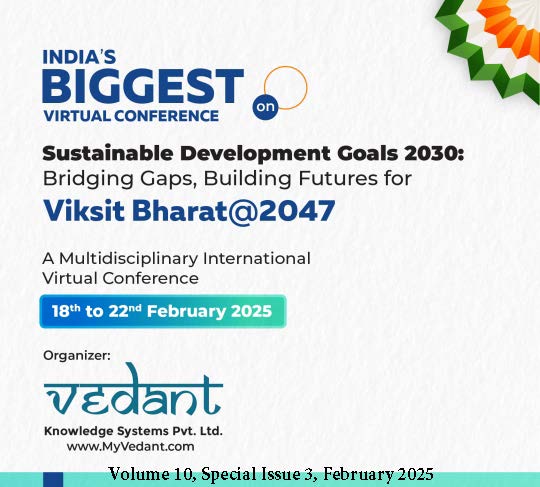Breaking the Cycle: Tackling Child Marriage, Social Injustice, and Gender Disparities in the Workforce
DOI:
https://doi.org/10.58213/vidhyayana.v10isi3.2259Keywords:
Gender inequality, Social issues & challenges, Labor force participation, Sustainable Development Goals, Child marriageAbstract
While "Gender Equality" is specified by SDG 5 and must be promoted by 2030, "Decent work for all," "sustained, inclusive, and sustainable economic growth," and "full and productive employment" are those of SDG 8. Suppose we concentrate on the labor market, where participation in the workforce by men is 80% globally percentage of women participation hardly exceeds 50%. The female participation rate in the workforce was 34.1 percentage in 1999–2000. This rate of participation decreased to 27.2 percentage in 2011–2012 (ILO report). Supply-side and demand-side factors can analyse the reasons for the low participation rate in the workforce. We get several supply-side problems for which women are unable to participate in labour market, among them, one of the most important reason is early-marriage. Marriage is the most crucial institution for the Individual and the society at large. For the Individual, it is a significant and memorable event in one’s life as well as the most important foundation in the family formation process. However, “Early age marriage is one of the most prevalent forms of sexual abuse and exploitation especially among the adolescent girls. It serves as a means of perpetuating power imbalances between men and women, both in the home and outside” (Ghosh, Jan-Dec., 2011). Early age marriage has adversely influenced Sustainable Development Goals (SDGs) and Millennium Development Goals (MDGs) in underdeveloped countries including India. Moreover, child marriage has five domains of impacts on adolescent girls: (i) fertility rate and population growth; (ii) health, nutrition level, and violence; (iii) level of educational attainment (iv) labor force participation, earnings, and productivity; and (v) power of decision-making and other areas (Wodon, et al., 2017).
Downloads
References
• Afridi. F and Dinkelman. T, Mahajan. K, “Why are Fewer Married Women Joining the Work Force in India? A Decomposition Analysis over Two Decades, IZA with JEL Classification: J21, J22 Feb 2016.
• Bandyopadhyay. A, Sen.S, Biswas. R, Dhawan.N, Chakravarti.U, Welchman. L, Hossain.S, Chowdhry. P, Chowdhury. I, Geraldine Forbes, Ghosh. B, T Sarkar, Sen. A, Dutta. A & Sen. S, Love Law & Labour, Sage Publication Ltd, 2021.
• Becker, Gary, S. (1993). “A Treatise on the Family .” National Bureau of Economic Research, Inc.204 Junipero Serra Boulevard, Stanford, CA 94305
• Bhattacharya. S, Cheung. W, Joshi. M, Priyadarshini. A “Time poverty for girls: Implication for Educational attainment and workforce participation,” 2023. https://www.ideasforindia.in/topics/human-development/time-poverty-for-girls-implications-foreducational-attainment-and-workforce-participation.html.
• Deshpande. A, Kabeer. N, “Norms that matter: Exploring the distribution of women’s work between income generation, expenditure-saving and unpaid domestic responsibilities in India,” World Development, Vol: 173, Working Paper, Feb 2024.
• Deshpande. A, Singh. J, “Why is the participation of Indian women in paid work declining?” Ashoka University, Feb 2023.
• Ghosh, B. (2011). Child marriage and its prevention: Role of adolescent girls. Indian Journal of Development Research and Social Action,7(1-2), Jan-Dec., 2011, 49-62.
• Khan. S, “Female education and marriage in Pakistan: The role of financial shocks and marital customs”, World Development, Vol: 173. Working Paper, Jan 2024.
• Klasen, S., and J. Pieters. (2012). Push or Pull? Drivers of Female Labor Force Participation during India’s Economic Boom, IZA discussion paper.
• Laitner, J. P. (2000). "Household Bequests, Perfect Expectations, and the National Distribution of Wealth." Econometrica 47(5): 1175-93.
• Ministry of Health and Family Welfare, Government. of India. (2019-21). Data from National Family Health Survey - V (2019-21) (NFHS - V).
• Nayan, M. (2015). Child marriage in India: Social maladies and government’s initiatives. International Journal of Applied Research, 1(5), 72 - 80.
• Raj, A., Saggurti, N., Balaiah, D., & Silverman, J. G. (2009). Prevalence of child marriage and its effect on fertility and fertility-control outcomes of young women in India: a cross-sectional, observational study. The Lancet, 373(9678), 1883-1889.
• Roy. A and Chauhan. P (2022), Exploring the Socioeconomic Factors Associated with Girl Child Marriage and its Impact on Pregnancy Outcomes: A Study from Malda District of West Bengal, Indian Journal of Community Medicine.
• Sen & Ghosh (2021), Love Labour and Law Early and Child Marriage in India.
• Surosree Nath. (2024): ” Navigating Time Poverty: Understanding the Challenges Faced by Women in Developing Countries”. Vidhyayana - An International Multidisciplinary Peer-Reviewed E-Journal - ISSN 2454-8596, 10(s1), 682–698. Retrieved from https://j.vidhyayanaejournal.org/index.php/journal/article/view/1987
• Wodon. Q, Male. C, Nayihouba. A, Onagoruwa. A, Savadogo, Yedan. A, Edmeades, J, Kes. A, John. N, Murithi. L, Steinhaus. M, and Petroni. S (2017), Economic Impact of Child Marriage : Global Synthesis Report. (Conference edition). This paper is jointly produced by the International Center for Research on Women (ICRW) and the World Bank (WB) and is available at www.costsofchildmarriage.org.
• Women's labor force participation in India: Why is it so low? ILO report, World Bank Gender Data Portal.
